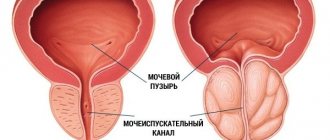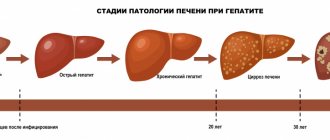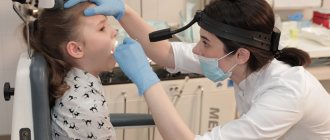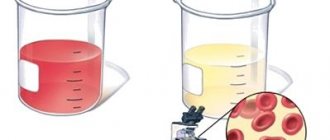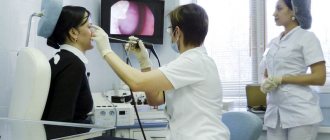Salpingitis is a disease of the fallopian (uterine) tube of an infectious-inflammatory nature. It can be unilateral, when infection occurs in one of the fallopian tubes, often this occurs due to inflammatory processes of nearby organs - for example, the appendix, and depending on which of the tubes is infected, the disease is divided into left-sided salpingitis and right-sided salpingitis. Bilateral salpingitis can also occur when both fallopian tubes are affected as a result of the inflammatory process. In addition, according to the form of its course, it is divided into acute, subacute and chronic, and according to etiology - into specific and nonspecific.
Acute and chronic salpingitis can affect reproductive function in women and cause spontaneous miscarriages, inability to become pregnant, and constant pain in the lower abdomen. As an isolated inflammation, salpingitis appears quite rarely; most often it occurs against the background of an inflammatory process of the ovaries - oophoritis and the uterus - endometritis.
Causes of the disease
Fallopian salpingitis appears as a result of viral or microbial infection, which can occur in three ways:
- With the ascending transmission of infection from neighboring organs - the uterus (with a cyst, endometritis), vagina (with vulvovaginitis, vaginitis), urinary ducts.
- By contact, when infection occurs through organs of other systems that have become infected - for example, due to appendicitis.
- Hematogenously, when the infection is transmitted through the blood.
Factors that provoke the appearance of salpingitis may be:
- sexually transmitted diseases - trichomoniasis, gonorrhea, herpes, chlamydia;
- performing abortions with curettage;
- use of intrauterine devices;
- the occurrence of injuries during labor;
- carrying out metrosalpingography, salpingoscopy;
- inflammatory diseases of nearby organs – appendicitis, oophoritis, colitis, pelvioperitonitis
Popular questions
I have inflammation of my left ovary.
The doctor prescribed me several injections and suppositories. Can I replace injections with tablets? Hello! I recommend that you consult your doctor regarding this issue to select adequate therapy and change the method of administration.
Hello, please tell me for all infections it says: not detected, but ureaplasma: 10*2.7 Is this normal?
Hello! Ureaplasma is a sexually transmitted infection. The microbial number can change with a decrease in immunity, as well as infect a partner. An identified infection requires treatment.
I suspect inflammation and cysts. The doctor prescribed IV thiosulfate, IM ceftriaxone, and Diclovit suppositories. I just didn’t explain, is it necessary to apply everything at the same time or what?
Hello! Most often, this complex of treatment is carried out simultaneously, but it is better to check with your doctor.
After being examined by a doctor, the external genitalia are inflamed, what should I do?
Hello!
I recommend using Ginocomfort gel with mallow extract, since most likely this is an allergic reaction to disposable instruments, gloves or talc. The gel is applied in a thin layer to the affected area once a day for 5-7 days. For an accurate diagnosis, contact a specialist
Causes and symptoms of acute salpingitis
Acute salpingitis occurs as a result of infection in the fallopian tubes along the ascending path or through an already existing focus - oophoritis, appendicitis. Very often, the development of this disease occurs against the background of an ectopic pregnancy and is accompanied by pronounced symptoms:
- increased body temperature;
- increased heart rate;
- general malaise, weakness;
- nausea and vomiting;
- headache;
- pain in the genital area - their localization is determined by the development of the inflammatory process in one of the fallopian tubes;
- specific discharge from the genitals - purulent, foamy, bloody, can be very copious and accompanied by itching and burning;
- disorders of stool and urinary function.
Symptoms of inflammation of the fallopian tubes
Acute form
- fever. In most cases, the temperature increases to 38-39°C. If the disease is caused by Mycobacterium tuberculosis, the indicators most often range from 37.5 to 38°C;
- headache, weakness;
- pain in the lower abdomen and back, which may worsen after sexual intercourse. The localization of pain depends on which tube is involved in the pathological process;
- pathological vaginal discharge, the nature of which largely depends on the type of pathogen. For example, with trichomonas infection they become foamy, when gonococci penetrate the body - purulent;
- painful and frequent urination caused by reflex irritation of the bladder, located in close proximity to the uterus and fallopian tubes;
- loose stool.
It is very important to consult a specialist in a timely manner and undergo a course of treatment for the disease, since otherwise the process may become chronic, which can lead to the development of dangerous complications.
Chronic form
The pain syndrome in this case is caused by inflammation with the formation of hydrosalpinx and the development of adhesions in the pelvis. It is important to keep in mind that the clinical picture is not always bright enough, so the appearance of any symptoms (primarily pain of various types in the lower abdomen and lower back) should be a reason to contact a gynecologist.
With salpingitis, changes occur in the fallopian tubes, which, if left untreated, can lead to obstruction and disruption of their function. In addition, further spread of the infection is possible, involving other pelvic organs in the pathological process.
Symptoms of chronic salpingitis
In most cases, chronic salpingitis does not have severe symptoms and does not cause the patient much discomfort. The woman feels well, the temperature is usually normal. Dull or aching pain in the abdomen and minor discharge may occur. Symptoms are wave-like, can subside and intensify as a result of stress and hypothermia. A characteristic sign of chronic salpingitis is disruption of the menstrual cycle, discharge during menstruation is profuse and accompanied by pain. A common prognosis for the development of this disease is the impossibility of pregnancy.
4. Treatment of acute purulent salpingitis
Acute purulent salpingitis in a short time leads to the accumulation of purulent exudate in the fallopian tube. Without surgical intervention, an abscess can very quickly lead to rupture and the development of peritonitis.
Depending on the diagnostic results, as well as after assessing the dynamics, the doctor decides on the advisability of surgical treatment. If the obtained data are prognostically favorable, therapeutic treatment may be prescribed. It is based on penicillin antibiotics, immunomodulators, antifungal and anti-inflammatory drugs. Antipyretic and painkillers are also prescribed symptomatically.
The prognosis for salpingitis is of great concern to women planning pregnancy. In the acute course, inflammation is treated better than in the case of chronic or latent infection, however, the preservation of fertility depends on the degree of coverage of the fallopian tubes by the adhesive process. In order to maintain and improve their patency, physiotherapy and biogenic stimulants can be prescribed. Planning a pregnancy by a woman who has had salpingitis should be under the supervision of a doctor, since there is a risk not only of difficulties with conception, but also of ectopic pregnancy, in which there is a high risk of rupture and other serious complications requiring emergency care.
Causes and symptoms of right-sided salpingitis
Right-sided salpingitis is characterized by inflammation in the right fallopian tube, caused by the activity of various pathogens - for example, chlamydia. The causes of infection can be sexual activity without using condoms, poor personal hygiene, and traumatic injuries as a result of gynecological surgical interventions. When infection penetrates the fallopian tube, swelling and disruption of blood outflow occur, severe thickening of the appendages and the formation of adhesions. A woman may have a fever, pain in the pelvic organs, and discharge. If right-sided salpingitis is diagnosed and treated in a timely manner, the consequences can be avoided and a complete recovery will occur.
Most Frequently Asked Questions
What type of anesthesia is used during surgery?
For more complete information, you should visit the special section of this site.
Is there any special preparation for surgical treatment for fallopian tube pathologies?
Those patients planning surgical treatment should study the section on preoperative preparation.
In which clinic can the operation be performed?
The initial consultation is carried out at the Swiss University Clinic in Moscow. You can also familiarize yourself with clinical sites located in Moscow or Switzerland.
Useful links to various sections of the site on surgical treatment of intrauterine diseases:
preparation for surgery for diseases of the fallopian tubes ... pain relief during surgery for diseases of the fallopian tubes ... simultaneous (simultaneous) operations for diseases of the fallopian tubes ... clinical sites ... reviews of other medical specialists
Causes and symptoms of purulent salpingitis
Purulent salpingitis usually occurs as a result of infection with gonorrhea. It can also be triggered by a miscarriage, an abortion performed outside the walls of a medical institution, or the use of expired uterine devices. A large amount of pus forms in the cavity of the fallopian tube, and when it penetrates into the abdominal cavity, peritonitis develops. The symptoms of purulent salpingitis are very noticeable. Body temperature rises, severe pain occurs in the lower abdomen, which can radiate to the lower back and rectum, purulent vaginal discharge, chills, and fever. This disease must be treated surgically; conservative methods are ineffective.
How life-threatening are the consequences of salpingitis?
Inflammation of the fallopian tubes in itself is not a deadly disease; the prognosis for treatment is almost always positive, unless complications arise: “sealing” of the fimbriae and the formation of hydro- (sacto-, hemato-) salpings or their suppuration (pyosalpings) involving the ovaries - “ tubo-ovarian tumors”, which may entail surgical treatment with removal of the fallopian tubes, and sometimes the appendages entirely or together with the uterus.
It should be noted that the speed of treatment and final restoration of the reproductive function of the female body may vary depending on how quickly the disease was stopped and therapy was prescribed.
In any case, this diagnosis is common, which means that modern gynecology, coupled with medicinal cosmetics based on effective ingredients, can help recover even after a serious illness.
Sources:
- POSSIBILITIES OF PRESERVING REPRODUCTIVE FUNCTION IN YOUNG WOMEN WITH ACUTE SALPINGITIS. Pokinchereda T.V. Chertovskikh M.N. Kulinich S.I. // Siberian Medical Journal. – 2009. – No. 7. – P. 70-73.
- MAGAZINE A MODERN VIEW ON THE ANATOMY AND FUNCTION OF THE FALLOPY TUBES. // Aketaeva A.S. – Clinical medicine of Kazakhstan. – 2021. – No. 2 (40). – pp. 14-21.
- Basic research methods and surgical interventions in gynecology. Kolgushkina T.N., Korshikova R.L., Peresada OA, etc. - Minsk, 1999. - 124 p.
- Hyperandrogenism syndrome in women. // Methodological manual for doctors, ed. Academician I.I. Dedova. M., 2003.
- Post-stroke cognitive impairment. Vakhnina N.V., Parfenov V.A., Yakhno N.N. // Journal of Neurology and Psychiatry. Stroke. - 2008. - No. 22. - P. 16-22.
- Mini-mental state: a practical method for grading the cognitive state of patients for the clinician. Folstein M., et al. // Journal of Psychiatric Research. - 1975. - No. 12. - R. 189-198.
- Pathologic correlates of incidental MRI white matter signal hyperintensities. Fazekas F., et al. // Neurology. - 1993. - Vol. 43. - P. 1683-1689.
- https://www.healthline.com/health/womens-health/salpingitis
- https://www.pubfacts.com/search/Salpingitis/2
- https://www.lecturio.com/magazine/salpingitis/
- https://research.omicsgroup.org/index.php/Salpingitis
Salpingitis along with oophoritis
The most common form of the pathological process is simultaneous inflammation of the fallopian tube and ovaries. Most often, the lesion occurs unilaterally, bilaterally occurs much less frequently. The inflammatory process originates on the mucous membrane of the fallopian tube and is then transmitted to the epithelium of the ovary. As a result, a pathological conglomerate is formed. It is necessary to begin treating salpingitis and oophoritis as quickly as possible in order to preserve the possibility of pregnancy in the patient.
Consequences
Acute salpingitis (inflammation of the fallopian tubes) is an infectious and inflammatory disease of the fallopian tubes, which requires immediate treatment. If therapy is prescribed delayed if a woman does not seek medical help in a timely manner or the treatment does not correspond to the cause of the development of salpingitis, complications may occur.
If the fallopian tubes are involved in the infectious process (diagnosis of salpingitis), rather unpleasant consequences may appear over time.
- Oophoritis. This is an inflammatory process that affects the ovaries during the transition of the infectious process from the fallopian tubes. When the uterine appendages are involved in the process, it is advisable to talk not about an isolated diagnosis (oophoritis), but about a combined infectious pathology - salpingo-oophoritis. This is an inflammatory process that involves both the fallopian tube and the ovary. Salpingoophoritis can be either unilateral or bilateral.
- Pyosalpinx and sactosalpinx. These are processes that are characterized by inflammation and the further formation of adhesions. Pyosalpinx (purulent inflammation of the fallopian tubes) is a process in which inflammatory contents (for example, pus) accumulate in the fallopian tubes. Sactosalpinx - tubes are filled with inflammatory contents (fluid-pus-like).
- Tuboovarian formation. When the fallopian tube and ovary are involved in the process and pus accumulates in the area of the uterine appendages, we can speak of a tubo-ovarian formation. This is a serious complication that can have consequences both for a woman’s reproductive function and for her health in general. If the integrity of such a formation is violated, severe peritonitis develops with all the ensuing consequences.
- Chronic pelvic pain syndrome. Many infectious agents that cause an inflammatory process in the uterine appendages leave behind a pronounced adhesive process. In this regard, many women, after suffering from salpingitis, complain of pain in the lower abdomen.
- Infertility. Unfortunately, inflammation in the fallopian tube can lead to adhesions in the lumen of the tube itself. As a result, the fallopian tube may become obstructed. That is, the meeting of an egg with a sperm is impossible. If the adhesive process is localized near the fallopian tube and interferes with the process of egg capture, surgical treatment is performed: excision of adhesions and administration of anti-adhesive drugs. If an adhesive process has formed inside the tube, then it may be impassable and pregnancy is impossible. There is a risk of relapse of adhesions after fallopian tube plastic surgery. In case of complete obstruction on both sides, IVF can be used to achieve pregnancy.
Diagnosis of salpingitis
Diagnostic methods include:
- conducting a gynecological examination;
- Ultrasound of the pelvic organs (ultrasound examination is performed transvaginally and transabdominally);
- bacteriological examination of a smear taken from the cervix, bacterial culture, smear analysis using the PCR method - one of the mandatory methods aimed at identifying sexually transmitted infections;
- performing laparoscopy;
- carrying out metrosalpingography.
During a gynecological examination, a vaginal examination using fingers and a speculum examination are performed. This ensures visualization of the vaginal walls and fornix, and the cervix. The presence of salpingitis is characterized by purulent mucus on the walls of the vagina and uterine cervix, as well as possible erosions, dysplasias, and neoplasms on the mucosa. During a digital examination, the gynecologist evaluates the shape and position of the uterus, fallopian tubes and ovaries. With salpingitis, soreness of the fallopian tubes and adhesive formations are detected.
To identify acute salpingitis, laparoscopy is one of the main diagnostic techniques, the accuracy of which is approximately 80-90%. This surgical intervention is performed under local anesthesia. Using a laparoscope, the fallopian tubes and ovaries are visualized and the presence of inflammatory processes in them is detected. You can also see purulent and blood accumulations in the oviducts.
Metrosalpingography is one of the radiopaque methods aimed at assessing the patency of the fallopian tubes. A contrast agent is injected into the uterine cavity and tubes, which is subsequently monitored on x-rays. Photos are taken with a delay. In the presence of obstruction, the contrast does not fill the fallopian tube at a certain level, which is most often caused by adhesions against the background of chronic salpingitis.
WHAT IS SALPINGITIS
Salpingitis most often develops in women aged 20-27 years.
Inflammation of the fallopian tube begins with the mucous membrane (endosalpingitis), then moves to the muscular layer and the outer serosa. When swelling spreads to the muscular layer of the fallopian tube, it thickens and deforms. As a result of the adhesive process as a consequence of the inflammatory reaction, the folds of the inner mucous membrane of the fallopian tubes become welded together, causing their obstruction. The accumulation of fluid in the tube leads to the formation of hydrosalpinx, and with suppuration - pyosalpinx. The disease often has a chronic course, with periods of remission and exacerbation. Isolated inflammation of the fallopian tubes is rare. The inflammatory contents from the pipe with the microbes it contains enter the abdominal cavity, causing symptoms of perisalpingitis and pelvioperitonitis. Between the inflammatory changes in the fallopian tubes, peritoneum, intestinal loops, and appendix, an adhesive process develops - perisalpingitis. Infection of a nearby ovary can occur - this is how adnexitis occurs. Chronic salpingitis is the main factor causing tubal infertility in women.
The cause of salpingitis is an infection that has entered the fallopian tube in one way or another and caused its inflammation. The main causative agents of inflammation of the fallopian tubes are gonococci, aerobic gram-negative microorganisms, non-spore-forming anaerobes (mycoplasma, chlamydia, viruses) and some others. Chlamydial infection causes a protracted course of the inflammatory process and in 25 - 45% of cases is the cause of tubal infertility. Salpingitis caused by the tuberculosis bacillus is a topic for a separate discussion and will not be discussed here.
Frequency distribution of microbial pools as a cause of tubal salpingitis:
| Pathogens | Acute salpingitis | Chronic salpingitis |
| Gonococcus | 45% | 20% |
| Chlamydia | 35% | 65% |
| Mycoplasma | 30% | 55% |
| Ureaplasma | 25% | 65% |
| Trichomonas | 65% | 30% |
| Escherichia coli | 30% | 20% |
| Cocci | 70% | 60% |
| Microbial association (Trichomonas + chlamydia) | 60% | 40% |
| Microbial association (mycoplasma + cocci) | 45% | 30% |
Risk factors for developing the disease:
- Sexually transmitted diseases: gonorrhea, chlamydia, herpes, trichomoniasis, etc.
- Surgical abortions (mini and with bone curettage).
- Intrauterine devices (insertion and wearing).
- Complicated birth (cesarean section, long anhydrous period, manual entry into the uterus, etc.).
- Intrauterine manipulations (...graphy, probing of the uterus).
- The presence of extragenital pathology of an infectious nature (chronic tonsillitis, pyelonephritis, etc.).
- Diseases of neighboring organs: cystitis, colitis, oophoritis, endometritis, appendicitis.
Predisposing circumstances:
- Stressful situations, depression;
- Reduced immunity;
- Lack of treatment for infections of other organs;
- Colds, ARVI;
- The presence of foci of chronic infection;
- Hormonal disorders;
- Bad habits (alcohol, use of mind-altering substances);
- Wrong, unhealthy diet.
Most often, women diagnosed with salpingitis by a gynecologist associate the disease with menstruation (40%), with hypothermia (25%), with intrauterine manipulation (15%), with the introduction of intrauterine devices (10%), with MSG or hysterosalpingography ( 3%). A number of patients indicate that the tubes first became inflamed after the onset of sexual activity, after practicing anal sex, and also after changing sexual partners. In most recent cases, barrier contraceptives were not used during intimacy.
What are the consequences of salpingitis for female reproductive health?
The fallopian tubes are a paired organ that is an integral part of the uterine appendages. In appearance, each of them resembles a hollow tube 10-11 cm long, opening into the uterine cavity in the area of its angle at one end and into the abdominal cavity near the ovary at the other. The lumen of the fallopian tube is covered with special epithelial cells; on their surface there are formations (cilia) capable of making wave-like movements (flickering). Beneath the layer of epithelial cells in the wall of the tube is a muscle layer. Thanks to the movements of the ciliated epithelium and contractions of the muscular wall, the fertilized egg moves towards the uterus from the abdominal cavity for the subsequent development of pregnancy. With salpingitis, their patency may be impaired, up to complete blockage of the lumen by adhesions. Pelvic adhesions are dense cords of connective tissue that form between the tubes and ovaries, uterine ligaments and other organs.
Treatment of salpingitis
Treatment of salpingitis in Moscow clinics is carried out using medicinal and surgical methods.
The following are prescribed as therapy:
- antibiotics – Ceftriaxone, Azithromycin, Doxycyline, Cefotaxime, Ampicillin, Metronidazole;
- anti-inflammatory drugs - Ibuprofen, Acetaminophen, Butadione, Paracetamol, Terzhinan suppositories, Hexicon;
- immunomodulatory agents – Imunofan, Polyoxidonium, Groprinosin, Humisol;
- antipyretics and antihistamines;
- vitamin complexes containing cocarboxylase, vitamins E, C;
- probiotics, antioxidants.
It is also possible to carry out physiotherapeutic procedures - electrophoresis with lidase, treatment with pulsed low-frequency ultrasound, reflexology, infusion therapy, heat therapy, diadynamic therapy, autohemotherapy. During treatment, it is advisable to adhere to a healthy diet and avoid the consumption of alcoholic beverages, which leads to a deterioration of the immune system and the functioning of the gastrointestinal tract.
It is possible to add traditional methods to drug therapy - taking baths with valerian, sage, juniper, rosemary, milk, douching with a herbal solution, using tampons with a decoction of plantain, aloe, cabbage, and consuming various herbal teas.
In cases of ineffectiveness of drug and physiotherapeutic treatment, as well as in the presence of tumor formations in the uterine appendages, adhesions causing obstruction of the fallopian tubes, accumulation of pus, and infertility, the patient is prescribed surgical intervention. First of all, adhesions and neoplasms are eliminated and normal patency of the fallopian tubes is restored. Surgical intervention is carried out by laparoscopy (the surgeon makes a small incision through which a miniature camera is inserted and the affected areas of the tubes are excised and their patency is restored) or laparotomy (the abdominal cavity in the area of the projection of the affected fallopian tube is dissected, the infected areas are eliminated, sanitation, dissection of adhesions is carried out formations).
Prevention of relapse
- Maintaining personal hygiene
The most obvious and important measure is the daily use of hypoallergenic intimate care products. Washing gel “Ginocomfort” is perfect as an addition to the course of treatment. One of the components of the gel - tea tree oil - is a natural antiseptic and perfectly fights germs and pathogens in the vulnerable environment of the vagina, without allowing them to penetrate deeper.
- Delicate conduct of any gynecological procedures
After severe inflammation, it is necessary, if possible, to allow the fallopian tubes to fully recover. The restorative intimate gel “Gynocomfort”, created to support women after suffering infectious diseases, will help heal microcracks in the vagina and return to its previous healthy state. - Using “barrier” contraception
In order not to provoke a conflict of microflora in an even weakened reproductive system, it is better to use condoms for the first time after recovery and, if necessary, use a lubricant, for example, Gynocomfort intimate gel-lubricant, which reduces friction. - Visit a gynecologist at least 2 times a year.
It is timely diagnosis of the condition of the internal and external genital organs that will help detect all possible diseases in the early stages and prevent complications. - Avoid self-medication
Salpingitis is a rather dangerous disease. If any of the above signs appear, make an appointment with a gynecologist and do not put off the visit. Otherwise, the risk of unpleasant complications increases significantly.
Salpingitis and the possibility of getting pregnant
If the patient suffers from unilateral salpingitis and treatment was started in a timely manner, her chances of becoming pregnant on her own without undergoing additional medical procedures and manipulations are very high. If the inflammatory process is traced in both uterine appendages, the probability of spontaneous pregnancy is one in ten. About twenty-five percent of women suffering from a chronic form of salpingitis receive a conclusion about the occurrence of infertility. Through the use of laparoscopic surgery, complete elimination of intrauterine adhesions is possible; competent drug therapy helps eliminate the inflammatory process. After long-term treatment, spontaneous pregnancy may occur.
In case of obstruction of the fallopian tubes, which cannot be restored, or in the case of removal of the oviducts, a woman’s opportunity to become a mother is realized using the IVF technique.
Treatment
Treatment includes a set of measures: conservative therapy, the use of physiotherapeutic methods, and increasing immunity.
Drug treatment usually involves taking antibiotics to eliminate the causative agent of the infection. In acute salpingitis, additional painkillers and anti-inflammatory drugs are often required. If a bilateral pathological process has been identified that has taken a chronic form, immunomodulators are prescribed.
In some cases, the doctor may recommend surgery, the purpose of which is to excise adhesions and restore patency of the fallopian tube.
It must be borne in mind that surgery to remove hydrosalpinx does not always allow one to achieve pregnancy, since even in the absence of obstacles, a fallopian tube with impaired function cannot take an active part in the process of transporting the oocyte. Sometimes the affected tube needs to be removed (tubectomy).
If, after treatment, it was not possible to restore fertility, IVF (in vitro fertilization) is recommended - a method that allows you to achieve pregnancy even in the absence of both fallopian tubes.
Diet
Diet in the treatment of salpingitis is ineffective and insignificant. However, some recommendations are still given:
- Drink plenty of fluids;
- Eat crackers;
- Consume more vitamins through foods;
- Periodically consume low-fat dairy products and meat.
There is usually no strict diet here. It is advisable to exclude alcohol as one of the bad habits that suppress the immune system and irritate the gastrointestinal tract.
Is it possible to be treated with folk remedies at home? Nobody cancels folk methods. However, they should not replace drug and surgical treatment, but supplement:
- Baths with juniper, sage, valerian, rosemary or milk.
- Douchings from herbal teas.
- Therapeutic tampons soaked in a decoction of aloe, plantain or cabbage.
- Herbal tea from various herbal mixtures.
Forecast
Timely treatment and adequate treatment guarantees complete cure and elimination of the consequences of the disease. The most favorable prognosis is when salpingitis does not cause obstruction of the fallopian tubes. In this case, treatment leads to complete recovery and restoration of reproductive function.
The later a woman comes, the worse the prognosis - the chronic form of salpingitis is difficult to treat. And delaying treatment is fraught with the development of various reproductive dysfunctions. There is a high risk of ectopic pregnancy.
What it is?
Salpingitis is an isolated infectious and inflammatory disease of the uterine (fallopian) tube of one or two-sided nature, often leading to its obstruction and, as a result, infertility.
As an isolated inflammatory process, salpingitis occurs infrequently; in most cases, inflammation from the area of the fallopian tubes spreads to the ovaries (oophoritis), and acquires the features of a combined inflammation of the appendages (salpingoophoritis). Often inflammation of the uterine appendages (ovaries and tubes) is combined with endometritis (inflammation of the uterus).
Causes of the disease
Salpingitis can be caused by pathogens of various types and classes of pathogenic and opportunistic microorganisms - bacteria, viruses, fungi and protozoa.
Depending on the causative factor, the disease is conventionally divided into:
- Specific salpingitis - often bilateral, is caused mainly by infectious pathogens that are sexually transmitted. Specific salpingitis is the most common cause of infertility. It is caused by chlamydia, trichomonas, mycoplasma, ureaplasma, gonococcus, cytomegalovirus, herpes simplex virus type II, papillomavirus infection, mycobacterium tuberculosis (very rare).
- Nonspecific salpingitis, which is caused mainly by epidermal or Staphylococcus aureus, streptococcus, Escherichia coli or enterococcus, gram-positive anaerobic microorganisms that do not form spores (peptococci and peptostreptococci), yeast fungus and some others. As a rule, the damage is unilateral.
An increased risk of inflammation of the fallopian tubes is observed in the following cases:
- Douching increases the risk of salpingitis, as it promotes the spread of bacteria from the vagina into the uterine cavity and fallopian tubes.
- Gynecological procedures (endometrial biopsy, curettage, hysteroscopy, abortion, etc.)
- If a woman has had many sexual partners with whom she has had sex without a condom.
- If a woman has previously had one of the sexually transmitted diseases (gonorrhea, chlamydia, trichomoniasis, etc.)
- The presence of an intrauterine device increases the risk of salpingitis in the first 4 months after insertion of the device.
Especially often, inflammatory processes are caused by multiple mixed microbial flora (polymicrobial association), for example, staphylococci with E. coli, gonococci with chlamydia, enterococci with staphylococci and streptococci, clostridia with peptostreptococci, E. coli with enterobacteria and Proteus, etc.
Each type of infection has its own routes of infection and features of the mechanism of development of the inflammatory process. For example, gonococcus is characterized by a purulent nature and bilateral damage.
Surgery
Treatment of salpingitis with surgical intervention is used in both acute and chronic forms of this disease. Indications for surgical treatment are determined by the attending physician.
Indications for surgical treatment of salpingitis are:
- ineffectiveness of conservative treatment;
- tumors in the area of the uterine appendages;
- the formation of purulent formations in the area of the uterine appendages;
- infertility of unknown origin;
- obstruction of one or both pipes as a result of adhesions.
The essence of the operation is to remove part of the fallopian tube, clean it of pus and disinfect it. If it is not possible to eliminate the purulent focus and restore the patency of the fallopian tube, the uterine appendage is removed. In case of chronic salpingitis with pronounced adhesions, adhesions are also removed.
The most effective method of surgical treatment of salpingitis is laparoscopic surgery. It involves removing parts of the tube using special equipment through small holes in the abdominal wall. If using this method it is not possible to perform a full-fledged operation, then they switch to laparotomy. This operation consists of an incision in the anterior abdominal wall, which is made in order to gain full access to the pelvic organs. The method is more traumatic and provokes the formation of new adhesions.
The operation is performed in several stages. Initially, the doctor makes three punctures on the abdomen, through which medical instruments and laparoscopic equipment are inserted. Next, using a laparoscope, a special gas (carbon dioxide or nitrous oxide) is pumped into the patient’s abdominal cavity. This is done to ensure that the organs move away from each other, providing the doctor with good visibility. A laparoscope is a hollow tube with an eyepiece at one end and a video camera at the other. Through the eyepiece, the doctor examines the internal organs, and using a video camera, the image is displayed on the monitor screen. The remaining incisions are intended for inserting manipulators, with which the doctor carries out the necessary actions.
During the operation, the adhesive formations are cut, and manipulations are carried out aimed at restoring the patency of the pipes. If inflammatory processes are detected during surgery, the doctor removes purulent formations, treats the cavity with disinfectant solutions and installs a drainage system in the abdominal cavity.
Laparoscopic treatment allows a woman to go home within three days after surgery, but the recovery process will last up to two weeks. At the same time, doctors advise patients to temporarily refrain from sexual intercourse and visit the gynecological office at least once every 3 months.


